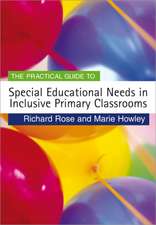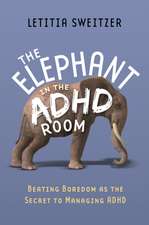How the Special Needs Brain Learns
Autor David A. Sousaen Limba Engleză Paperback – 18 mai 2016
Preț: 313.80 lei
Nou
Puncte Express: 471
Preț estimativ în valută:
60.05€ • 65.21$ • 50.44£
60.05€ • 65.21$ • 50.44£
Carte disponibilă
Livrare economică 02-16 aprilie
Livrare express 18-22 martie pentru 55.07 lei
Preluare comenzi: 021 569.72.76
Specificații
ISBN-13: 9781506327020
ISBN-10: 1506327028
Pagini: 296
Dimensiuni: 216 x 279 x 23 mm
Greutate: 0.91 kg
Ediția:Third Edition
Editura: SAGE Publications
Colecția Corwin
Locul publicării:Thousand Oaks, United States
ISBN-10: 1506327028
Pagini: 296
Dimensiuni: 216 x 279 x 23 mm
Greutate: 0.91 kg
Ediția:Third Edition
Editura: SAGE Publications
Colecția Corwin
Locul publicării:Thousand Oaks, United States
Recenzii
"How the Special Needs Brain Learns makes a distinct contribution to the field. It provides knowledge of the neurological basis of learning without inundating the reader with biological terminology. The various categories of disabilities are defined and described in terms that teachers can understand. But Dr. Sousa does not leave the reader there. He arms the reader with strategies to address various disabilities and a plethora of ways to support their learning and emotional needs. The teacher-friendliness of this book makes it stand out in its field."
"Understanding how individuals learn…or why they may fail to learn…is an integral part of what makes teachers effective with students who have special learning needs as well as with those who don’t. Dr. Sousa’s text provides an easy-to-read explanation of both how the brain functions and how that functioning impacts the learning process. But it doesn’t stop there. Each chapter offers practical information, suggestions, or strategies that can be used to help struggling students learn."
"Understanding brain development is of critical importance to the field of education. Of all the books I have used, those written by David Sousa have been the most readable and understandable. The strategies included in this new edition of How the Special Needs Brain Learns can be easily carried out in the classroom. I think I have all that he has written regarding the brain."
"How the Special Needs Brain Learns, Third Edition provides key biological and neurological information for issues that I think many teachers attribute purely to attitude and will. By providing the specific neurological processes behind learning difficulties, Dr. Sousa gives teachers and teacher candidates a useful resource to understand and respond to challenges experienced by students with learning difficulties and special educational needs."
"A major strength of the third edition of How the Special Needs Brain Learns is that it clearly addresses all major areas of learning in which students with disabilities experience problems. The author has done an excellent job in balancing what we know about the brain and how this can be applied in the classroom. It bridges the field of neuroscience and education well!"
"Understanding how individuals learn…or why they may fail to learn…is an integral part of what makes teachers effective with students who have special learning needs as well as with those who don’t. Dr. Sousa’s text provides an easy-to-read explanation of both how the brain functions and how that functioning impacts the learning process. But it doesn’t stop there. Each chapter offers practical information, suggestions, or strategies that can be used to help struggling students learn."
"Understanding brain development is of critical importance to the field of education. Of all the books I have used, those written by David Sousa have been the most readable and understandable. The strategies included in this new edition of How the Special Needs Brain Learns can be easily carried out in the classroom. I think I have all that he has written regarding the brain."
"How the Special Needs Brain Learns, Third Edition provides key biological and neurological information for issues that I think many teachers attribute purely to attitude and will. By providing the specific neurological processes behind learning difficulties, Dr. Sousa gives teachers and teacher candidates a useful resource to understand and respond to challenges experienced by students with learning difficulties and special educational needs."
"A major strength of the third edition of How the Special Needs Brain Learns is that it clearly addresses all major areas of learning in which students with disabilities experience problems. The author has done an excellent job in balancing what we know about the brain and how this can be applied in the classroom. It bridges the field of neuroscience and education well!"
Cuprins
List of Strategies to Consider
About the Author
Preface to the Third Edition
Acknowledgments
Introduction
Chapter 1 - The Brain and Learning
Chapter 2 - When Learning Difficulties Arise
Chapter 3 - Attention Disorders
Chapter 4 - Speech Difficulties
Chapter 5 - Reading Disabilities
Chapter 6 - Writing Disabilities
Chapter 7 - Mathematical Disabilities
Chapter 8 - Emotional and Behavioral Disorders
Chapter 9 - Autism Spectrum Disorder
Chapter 10 - Putting It All Together
Glossary
References
Resources
Index
About the Author
Preface to the Third Edition
Acknowledgments
Introduction
Chapter 1 - The Brain and Learning
Chapter 2 - When Learning Difficulties Arise
Chapter 3 - Attention Disorders
Chapter 4 - Speech Difficulties
Chapter 5 - Reading Disabilities
Chapter 6 - Writing Disabilities
Chapter 7 - Mathematical Disabilities
Chapter 8 - Emotional and Behavioral Disorders
Chapter 9 - Autism Spectrum Disorder
Chapter 10 - Putting It All Together
Glossary
References
Resources
Index
Notă biografică
Descriere
Teaching students with learning challenges just got easier with this groundbreaking guide!
If you’ve been searching for effective strategies to meet the needs of learning challenged students, look no further. In this newly revised and updated third edition, expert David A. Sousa addresses the causes of common learning disabilities and provides alternative instructional strategies to ensure learning occurs. Discover cutting-edge brain research to help you:
If you’ve been searching for effective strategies to meet the needs of learning challenged students, look no further. In this newly revised and updated third edition, expert David A. Sousa addresses the causes of common learning disabilities and provides alternative instructional strategies to ensure learning occurs. Discover cutting-edge brain research to help you:
- Effectively instruct students with ADHD, LD, dyslexia, autism, and more
- Utilize assistive technologies to remove barriers to learning
- Differentiate instruction in speech, reading, writing, and mathematics











